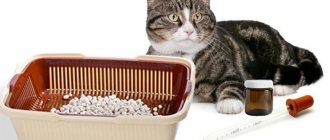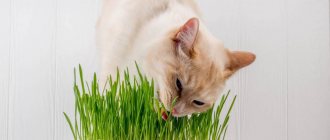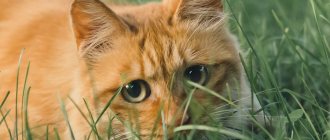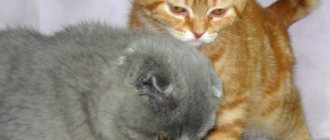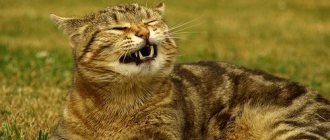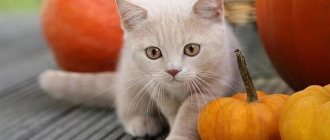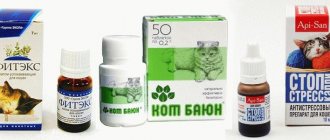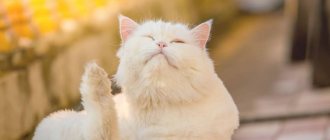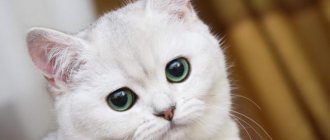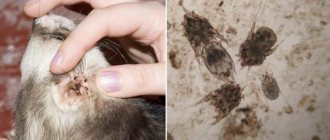Green, juicy grass for cats is a complete, affordable food in a pet’s diet. Young shoots contain the vitamins, minerals and fiber necessary for your pet. Planting grass is not difficult: in summer - on a summer cottage, in winter - on a windowsill. Having at your disposal the usual seeds of any cereal and a suitable container, you can provide your cat with fresh herbs, even without sowing them in the ground, at any time of the year.
Self-grown grass is a good alternative to indoor and garden flowers, most of which are dangerous to your pet’s health.
Benefits and harms
The beneficial substances contained in the herb have a beneficial effect on the health of the pet, namely:
Normal hematopoiesis in an animal occurs thanks to chlorophyll.
- Fiber improves digestion and cleanses the stomach of undigested food particles through the gag reflex.
- Vitamins and microelements strengthen the pet's immunity.
- Chlorophyll has a positive effect on the brain, supplies the body with oxygen, and participates in the process of hematopoiesis.
For improved intestinal function, including loosening stools, veterinarians recommend giving your pet sprouted seeds, and narrow blades of grass for strengthening. Grass can cause harm to your pet if the cat has eaten greens treated with herbicides. Domestic cats that are not outdoors and deprived of the opportunity to eat grass can encroach on potted indoor plants, most of which contain toxins that are dangerous to the animal.
Can a cat eat hay?
Once in the supermarket, the author of the article saw hay for rabbits and thought that the cat would probably like to roll around in it and smell the smell. And so it happened. But before the cat began to wallow, she began to greedily eat the hay. Can a cat eat dried grass?
On the one hand, hay can perfectly cleanse the stomach if wool is clogged in the gastrointestinal tract. How? So is the grass. Either push through or induce vomiting. But the trouble is that hay consumed in too much quantity can itself clog the intestines. It is unlikely that it will come to an operation to remove it, but it is still unpleasant.
The author’s cat, after eating a lot of hay, stopped bowel movements for a couple of days, although before that she had bowel movements every day. Then she walked off on her own, without help. Hay was still available, but the cat had already satisfied its greed and only occasionally came up to eat. Mostly it was lying around in the box with it.
Conclusion: dried grass consumed in small quantities does not lead to problems - in the following days the cat nibbled on the hay and went to the toilet as usual. However, if you bring home hay and see your cat's insatiable appetite, it is still better to remove the grass from access. Avoid eating large quantities at once.
Rate and share!
Can you grow it at home?
To grow your own grass, you need cereal seeds, a suitable container and soil. There is a way to grow grass at home without soil. You can buy different types of grass seeds for cats at a pet store or regular grain at the farmer's market. 2-3 glasses of cereal grains are enough to provide your pet with vitamin greens for the whole season. Lush grass grows quickly under greenhouse conditions, but you need to ensure that the greens do not dry out ahead of time by moistening and spraying the soil. It is good to sow the seeds in several containers at once with an interval of 3-4 days, so that while the cat eats the first harvest, new shoots will grow in the second tray. If it is impossible to grow grass at home, you can buy ready-made greens without chemical additives, the name of which is “Grass for Cats” from the Titbit brand. There are step-by-step instructions for the fortified food. The disadvantage is the high price.
Three ways to grow grass at home
In order not to risk the safety of your pet, you should not buy seed on the market. There is no guarantee that it has not been treated with toxic agents. Buy a few bags of special grass from a pet store.
Experienced cat owners know three ways to sprout grass for their pet on the windowsill.
- The first method allows you not to buy soil and not to spread dirt at home. You shouldn’t expect a big harvest, but if you want to offer grass to your cat for the first time, you can try this method. You will need two plastic plates of different diameters, cotton wool, coarse gauze and plastic film. At the bottom of a wider plate, having previously made several punctures in it, lay out cotton wool, water it with water and lay out seeds, cover it with gauze, top it with another plate and wrap it in polyethylene.
- The second method already involves the use of soil, which is sold in any flower shop. The soil is poured into any suitable container - a pot, flowerpot, tray or box. The seeds are soaked in water for about 50 minutes, the soil is slightly moistened to speed up germination and sown. You need to sprinkle the seeds with soil on top and cover them with plastic wrap - this will create a greenhouse effect. In about three days the shoots will emerge and the film will be removed.
- Instead of soil, you can use vermiculite or cat litter - this is the third method. Planted in the same way as the second method. The filler must first be soaked with water until it becomes mushy.
When the grass sprouts, it needs to be watered periodically - a little water 1-2 times a day every day. Remember that you do not need to plant an entire plantation. Only young shoots are useful for cats; plant greens as needed.
If the cat likes the grass, then use the conveyor sowing method. After planting the first batch, wait until they hatch, and a week later plant the second, and a week later the third. The cat will be provided with fresh grass.
What kind of grass do you need?
Fluffies can eat lemon balm.
Cats can be given plants such as:
- Melissa;
- cat mint;
- thyme;
- valerian;
- oats;
- wheat;
- rye;
- barley.
Valerian, mint, lemon balm, thyme, lemongrass excite your pet or, conversely, calm it down. Such herbs are more attractive to animals due to their smell. Cats prefer to eat cereals. Sprouts of fresh grass in winter are very useful. This is the best vitamin supplement for the animal’s excellent well-being. Outdoor cats eat a grass called sow thistle, known as weed. But it has medicinal properties that have a beneficial effect on the health of the pet. An animal with fur of any color, be it gray, red, black and white, outdoor or indoor, needs fresh greens.
The most favorite herb for furry pets is sprouted oats. The young cereal is rich in folic acid, carotene, potassium, magnesium, silicon, and is therefore recommended by veterinarians for inclusion in the diet of a pregnant cat and a growing kitten.
Growing grass at home
A cat owner who loves and appreciates his pet will notice that he has begun to chew on an indoor flower, and after that he will take care of the presence of fresh and juicy grass specially grown for the cat in the house. It is not difficult to grow it; for this you will need to buy seeds and, possibly, high-quality soil. You can immediately buy a ready-made planting kit. Cat grass is especially valuable for the animal’s body in winter.
Owners often plant sprouted oats for their pets. It quickly turns into green grass, but requires the greenhouse effect to grow. Oats can also be sprouted at home. It is better if the seeds are planted in three containers at once: while the pet is eating the first seed, shoots are already growing in the second box, and the first shoots are visible in the third.
Seed selection
Cat grass seeds are found almost everywhere. You can also buy them online - this is convenient, because the attached photographs immediately show what the end result will be. Do not buy grass seeds for cats from the market at very low prices , as you may stumble upon low-quality products or grains that have been treated with life-threatening substances.
What do cats like?
It is believed that the most favorite cat herbs are valerian and mint. Valerian tends to excite animals, although some may fall into a very deep sleep. Mint calms angry pets. However, cats appreciate only the smell of these herbs, but they prefer completely different varieties to eat. Names of the most popular grass for cats :
- rye;
- green oats;
- wheat;
- barley.
These seeds are sold in stores, after which they can be grown at your own dacha.
What cats don't like
If these pets simply adore valerian, then the most hated thing for them is onion and wormwood. In addition, I really like the smell of citrus fruits, especially lemon. If you want to discourage your cat from a certain place, place lemon peels there. They also do not like rue; the essential oil and branches of this plant disgust cats.
How to plant?
Growing seeds without soil
During the growing period, seedlings should be covered with gauze.
If you don’t have soil at hand, you can germinate oats for your cat using 2 plastic plates of different sizes and cotton wool. The yield with this method of germination is lower than when sowing seeds in the ground. After your pet eats the greens, they need to be re-sowed. The procedure for planting grains without a substrate is as follows:
- Make holes in a small plate to get rid of excess water.
- Moisten the cotton wool and spread it along the bottom of the holed container.
- Place the smaller plate on top of the larger one.
- Place the grains on moistened cotton wool.
- Cover the sown seeds with gauze.
- Wrap both plates in film and place on the windowsill.
- After seed germination, remove the polyethylene.
- Water the young grass little by little with clean water 1-2 r. in a day.
Method of planting in the ground
If soil was used to germinate grains, then the owner of the fluffy will be able to reap several harvests.
In another way, oat grass is planted using garden soil, substrate or soil for flowers. You can sprout greens in a pot, but to ensure stability, it is better to take a container with a wide base and sides up to 5 cm. Grass for cats grown in the ground is removed more than once. You can plant oats for cats in the ground like this:
- Pre-soak the grains in water for 1 hour.
- Pour soil into the prepared container.
- Moisten the soil base.
- Spread the seeds on a moistened substrate.
- Sprinkle a layer of earth no more than 1-2 cm on top.
- Add water.
- Stretch the film on top to create a greenhouse effect.
- Leave the mini-garden for 3 days at the optimal temperature for germination, 24-25°C, during which time the seeds should germinate.
- Remove the polyethylene after 4 days and place the container on the windowsill.
- After a week, young green shoots can be offered to your beloved pet.
Why do cats eat grass?
If you see your pet eating grass on the street, there is no need to forbid him to do so. There are several versions as to why cats need greens:
- Stomach cleansing. There is practically no coarse fiber in animal food, which forms the basis of a cat's diet, but it is found in abundance in food of plant origin. Moving along the esophagus, the latter cleanses its walls from pieces of food stuck to them and hair licked during washing and removes them from the body by belching.
- Normalization of intestinal function. Eating grass allows you to get a mild laxative or fixative effect. The first is achieved through regurgitation, the second - by the substances contained in the greens. With different digestive problems and given a choice, your pet will eat different grasses. To relax the intestines, he will give preference to broad-leaved plants, and to strengthen them - narrow-leaved ones.
- Diet expansion. The grass contains a lot of useful micro- and macroelements, vitamins, amino acids. When bearing offspring, the cat eats greens containing folic acid to improve the enrichment of blood with oxygen. Felinologists, during their observations of four-legged experimental subjects, found that they choose familiar plants without trying to try something new. Based on this, we can conclude that eating grass by these animals is more of a habit than a search for elements missing in the body. Moreover, some substances not contained in food of animal origin are synthesized independently in the cat’s body.
- Self-medication. Some scientists adhere to this version. However, when examining many cats that often eat grass, veterinarians did not detect acute or systemic pathologies in them.
- Taste preferences. Some cats do not swallow grass, but only bite it, from which we can conclude that they simply like its taste.
What herbs should a cat not eat?
After eating ivy, your pet will simply become poisoned.
Indoor flowers are dangerous for cats, most of which contain poisonous juice. Especially harmful are philodendron, dieffenbachia, alocasia, monstera, ficus, azalea, caladium, spurge, croton, oleander, adenium, cyclamen, delphinium, ivy, and chrysanthemum. Garden flowers such as lilies, gladioli, tulips, hyacinths, lilacs, pansies, carnations, snowdrops, and primroses are harmful. If a cat eats indoor plants, he is in danger. Once inside, a small piece of a poisonous plant can seriously harm a pet’s health, for example, cause a burn to the mucous membranes, vomiting, diarrhea, provoke nervous disorders, impair coordination, cause kidney failure, heart problems, lead to loss of vision if toxic juice gets into the eyes, possible cases of death. At the first signs of poisoning, you need to provide first aid to the animal and immediately contact a veterinarian.
To protect your pet from dangerous plants, you should not keep them in the house or prevent the animal from accessing flower pots and vases with bouquets. Citrus peels, which cats really dislike, are suitable for this purpose. It is placed near dangerous plants. Also, cats do not like rue, onions, and wormwood.
Mr. Cat recommends: what to do if your cat likes to eat grass?
You should not interfere with your pet’s desire to chew vegetation. Of course, it is necessary to remove indoor flowers from the access zone; many of them can be poisonous and dangerous for the cat.
Instead, you can purchase special mixtures for germination or ready-made pots of herbs in the store. Most often, cereal sprouts are used as vitamin treats: barley, oats, wheat. You need to understand that cats' tastes may differ.
Some pets prefer to chew on a piece of cucumber or fresh pumpkin seeds. It is important to offer your animal several different options.
Incomprehensible secrets of nature
So far, no one can say for sure and with certainty why and why cats eat grass. But still, several versions exist to explain this mystery of nature:
- Replenishment of the diet. Yes, cats are carnivores, but they also require a certain amount of fiber. It promotes full growth and development. The plants contain vitamins Bc and B9, namely folic acid, which cats require during pregnancy.
- As a laxative. In free and wild conditions, cats eat food (usually small animals) along with fur, which is not digested by the body. The same situation occurs in domestic cats when they lick themselves. Hairballs enter the stomach, are not digested, causing coughing and vomiting. The grass, entering the body, causes vomiting in the animal. This helps the body get rid of unnecessary “garbage”. And fiber helps the intestines work like clockwork.
- As a fixative. Many owners notice that their pets enjoy eating grass when they suffer from diarrhea. Then the animals prefer grass with narrow but dense stems. But for constipation, on the contrary, with a rather wide stem.
- "Chest with vitamins." Almost every cat does not receive the amount of vitamins and nutrients that are needed for a normal life. But forcing pills in and dripping solutions is not an option. A cat in need of vitamins will choose grass as a treat. After all, plants contain a huge amount of the same vitamins and minerals that tailed animals need so much. By finding out what kind of grass your pet prefers, you can determine which microelement or vitamin is missing in his body.
- Pleasure. Often a cat will bite a blade of grass but not eat it. Most likely, she likes the sap coming out of the plant.
Why don't all cats eat domestic grass?
Sometimes it happens that the owner spent time and effort growing grass, but the animal refuses to eat it. Why is this happening? There may be several reasons for a pet’s refusal to eat greens:
- The cat does not need such food. Cats are smart creatures. They know exactly what their body needs. If an animal refuses grass, there is no need to force-feed it or try to mix it into the food - instead of benefit, this can cause harm.
- The pet does not like the greens grown by the owner. Cats, like people, have taste preferences. Even though most sprouts look the same, they taste different. Some cats prefer rye, others prefer oats, and others prefer wheat. When germinating grains yourself, it is recommended to start from your pet’s taste preferences, finding them out experimentally. If the cat does not eat sprouted oats, you should try growing wheat or rye.
- The sprouts have overgrown, becoming tough and tasteless. Cats happily eat exclusively juicy young shoots.
Useful properties of plants
A large number of cat owners believe that there is no need to grow grass for cats themselves. It is enough to let the animal out for a walk for a couple of hours, and it will choose what kind of grass to eat. But this should not be allowed for the following reasons:
- In urban environments, grass is no longer so safe. Plants absorb all harmful substances: gases from cars, poisons from insects, reagents and much more. Anything can happen to a pet’s body, which absorbs not only fiber, but also a whole range of harmful substances.
- Plants brought in from the street may contain eggs of a wide variety of parasites, the most famous being worms. And treatment for helminths will be added to the restoration of a weakened body.
- Not all animals are endowed with a good sense of smell and are able to choose the right grass. Cats, eating this or that vegetation even in their own garden, may not notice the danger. Someone is cured after consuming an unknown plant, while others are taken to the veterinarians. Poisoning is especially dangerous in older animals and kittens.
It is not uncommon for animals to choke on spikelets, cut their tongues on sharp leaves, or get even more problems by eating weeds and plants with poisonous sap.
